Note. The engine is very heavy, so we recommend removing it with helpers.
Attention! When removing and installing an engine with a large mass, use only fully serviceable lifting mechanisms designed for the appropriate load, and especially carefully control the correctness and reliability of connecting cables, traverses, etc. to the transport eyes of the engine.
1. For convenience, remove the hood (see «Removal and installation of a cowl»).
2. Reduce the pressure in the supply system (see «Reducing the pressure in the power system»).
3. Disconnect the wires from the battery and remove it from the car (see «Removing and installing the battery»).
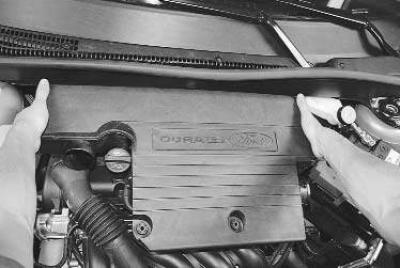
4. Remove the air inlet sleeve and air filter (see «Removal and installation of the air filter»).
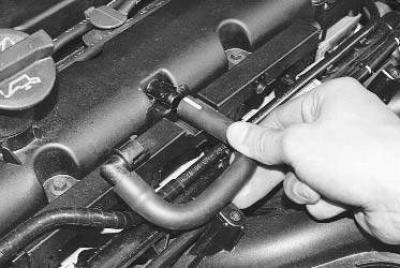
5. Remove the pipeline of the crankcase ventilation system (see «Cleaning the crankcase ventilation system»).
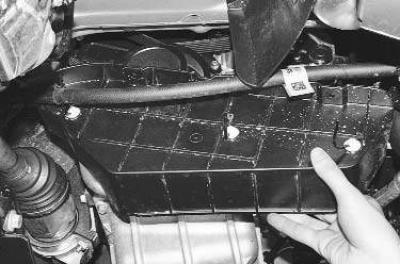
6. Remove the engine mudguard (see «Removal and installation of a mudguard of the engine»).
7. Drain the cooling system (see «Coolant replacement»).
8. If you remove the engine for repair, drain the oil from the oil sump (see «Changing engine oil and oil filter»).
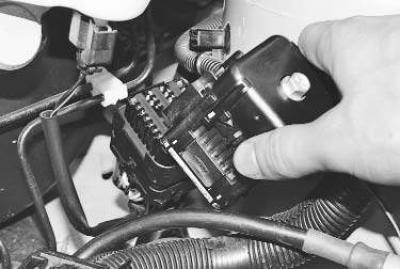
9. Turn out a fixing bolt and disconnect block of a plait of wires of a motor compartment.
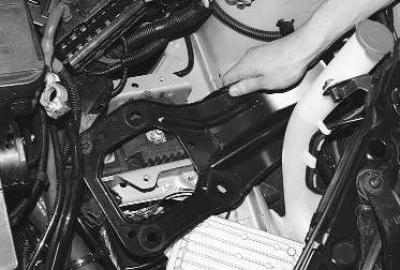
10. Remove the battery shelf and shelf bracket (see «Removal and installation of an arm of the shelf of fastening of the storage battery»).
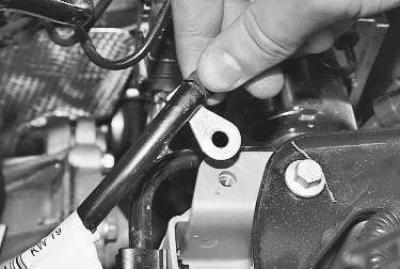
11. Disconnect from the body bracket two «massive» wires by unscrewing the bolt of their fastening.
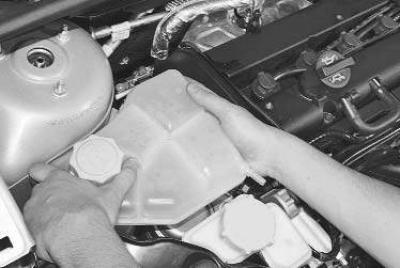
12. Remove the expansion tank of the cooling system from the body brackets, disconnect the hoses from it (see «Removal and installation of a broad tank»).
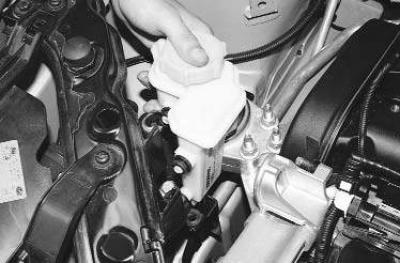
13. Disconnect the power steering reservoir from the bracket by unscrewing the fastening bolt and move the reservoir aside.
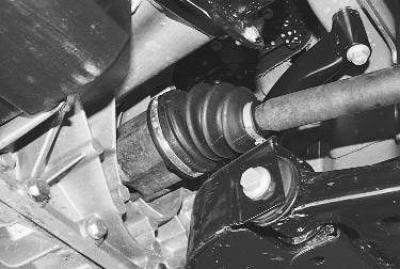
14. Remove the front wheel drives (see «Removal and installation of front wheel drives»).
15. Remove the A/C compressor drive belt (see «Accessory drive belt replacement»).
16. Remove the accessory drive belt (see «Accessory drive belt replacement»).
17. Remove the radiator of the cooling system (see «Replacing the cooling system radiator»).
Note. If the car is not equipped with air conditioning, the radiator can be left in place. It is enough to disconnect the outlet hose from the lower radiator pipe.
18. Turn out bolts of fastening of the compressor of the conditioner. Without disconnecting the pipelines from the compressor, take it to the side and secure it in any way possible (e.g. tying with wire).
19. Disconnect the power steering pump from the engine (see «Power steering pump replacement»), and then, without disconnecting the pipelines from it, take it aside and fix it in the same way as you fixed the air conditioning compressor.
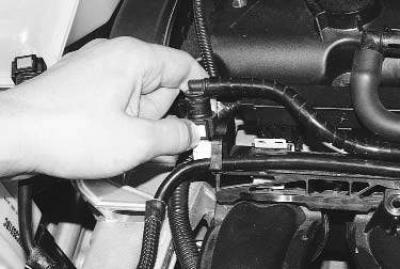
20. Squeezing the clamps, disconnect the fuel supply pipeline..
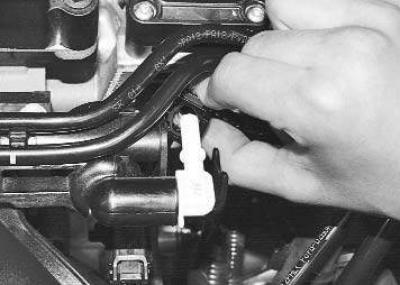
21.... and the adsorber purge pipeline.
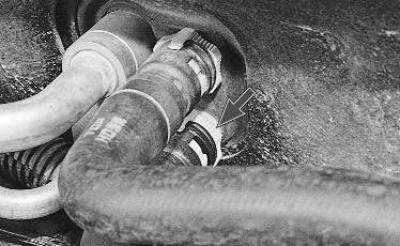
22. Disconnect the interior heater outlet hose by turning its retainer counterclockwise.
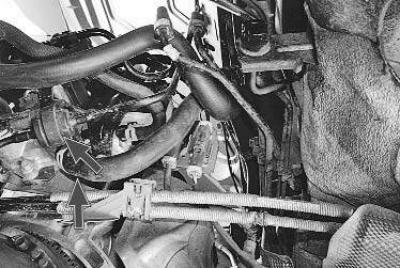
23. Squeezing the clamps with pliers and sliding them along the hoses, disconnect the steam outlet hose supplying the interior heater hose..
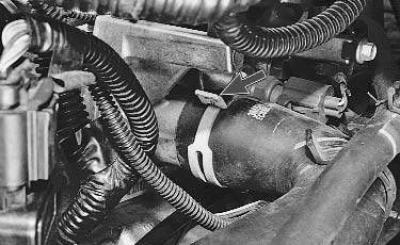
24.... and the radiator inlet hose from the outlet pipe of the engine water jacket located under the ignition coil.
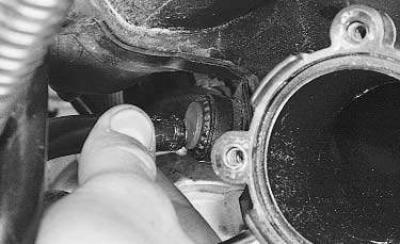
25. Disconnect from an inlet pipe the pipeline of the vacuum amplifier of brakes.
Note. Throttle assembly removed for clarity. When removing the engine, it is not required to dismantle it.
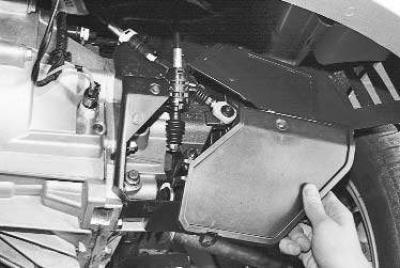
26. Unfasten seven latches of a cover of a casing of the mechanism of a gear change and remove a cover.
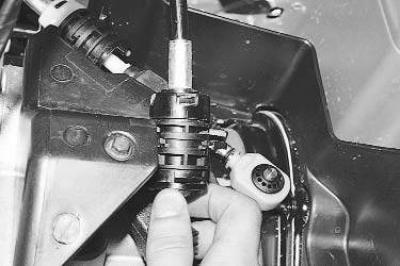
27. Remove the ends of the cable sheaths from the brackets on the gearbox (see «Replacing the transmission control cables») …
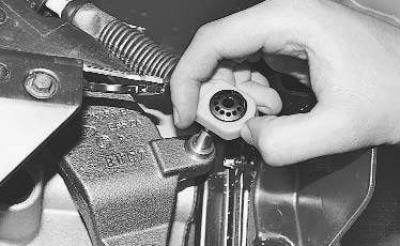
28.... and remove the cable ends from the gearshift levers.
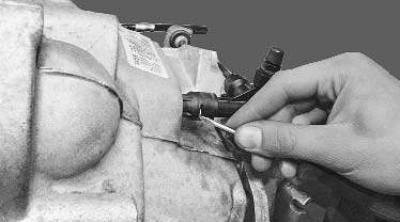
29. Prying with a screwdriver..
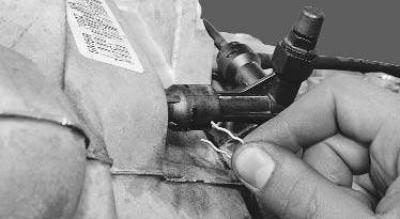
30.... remove the spring retainer of the adapter of the working cylinder of the hydraulic clutch release..
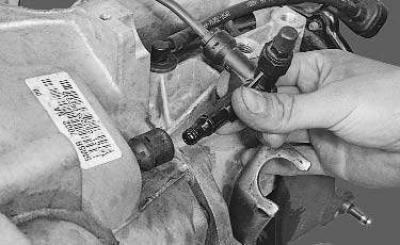
31.... and disconnect the adapter from the clutch housing along with the hydraulic clutch release pipeline.
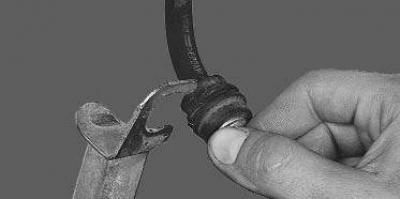
32. Remove the clutch release line hose holder from the bracket on the gearbox and move the line aside.
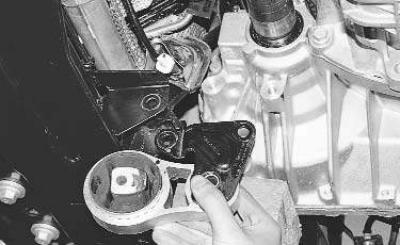
33. Place a secure support under the engine and remove the rear suspension support of the power unit (see «Replacing the suspension bearings of the power unit»).
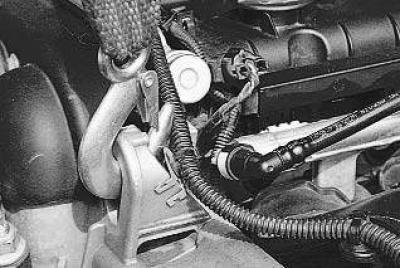
34. Attach the slings of the lifting mechanism to the front..
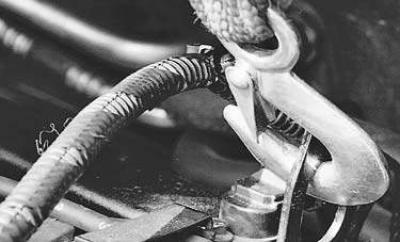
35.... and the rear transport eyes and tighten the slings.
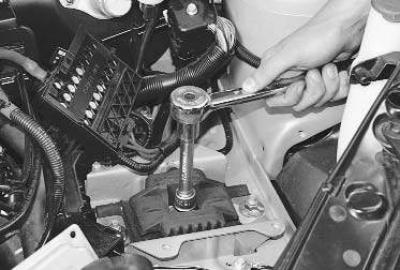
36. Turn out a bolt of fastening of the left support of a suspension bracket of the power unit to an arm on a transmission.
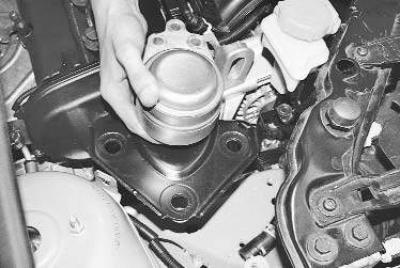
37. Remove the right suspension bracket of the power unit (see «Replacing the suspension bearings of the power unit»).
38. Check again that all wires, hoses and attachments are disconnected from the power unit.
39. Remove the support from under the engine and lower the power unit down to the floor.
40. Hang the front of the car (raise the car on a lift) to a height sufficient to remove the power unit from under the vehicle, and place reliable supports under the body.
41. Remove the power unit from under the car.
42. Establish the engine and all removed knots and details in sequence, return to removal, taking into account the following:
- before installing the power unit, clean the threaded holes for fastening its supports with a tap from rust;
- be sure to replace the gasket of the collector with a new one;
- when connecting wires and pipelines, carefully monitor their correct location in the engine compartment, avoiding contact with heating and moving elements of the power unit.
After installing the engine, do the following.
1. Fill engine oil (see «Changing engine oil and oil filter»).
2. Fill the gearbox with oil (see «Changing the oil in the gearbox»).
3. Fill with coolant (see «Coolant replacement»).
4. Adjust the gearbox control actuator (see «Gearbox control drive adjustment»).
5. Remove air from the hydraulic clutch release (see «Bleeding the hydraulic clutch release»).
6. Start the engine and check for fuel, oil and coolant leaks. Check oil pressure. Listen to the engine: it should run smoothly, without extraneous noise and knocks.
Visitor comments